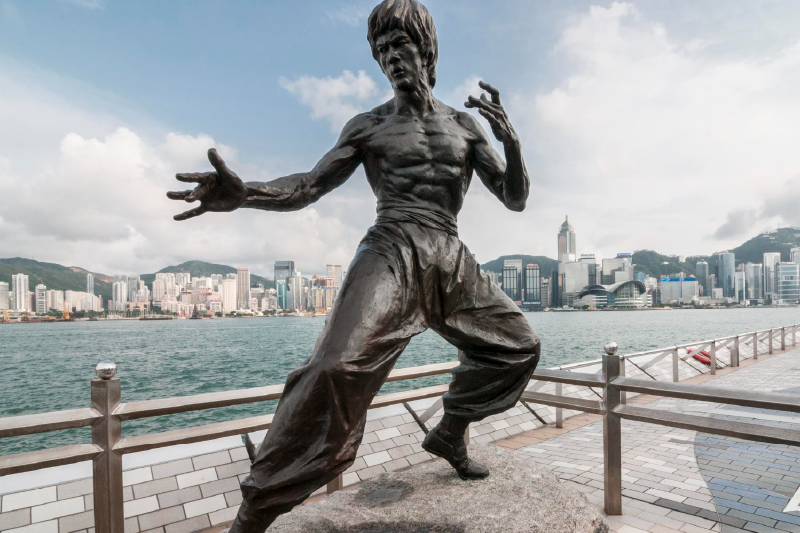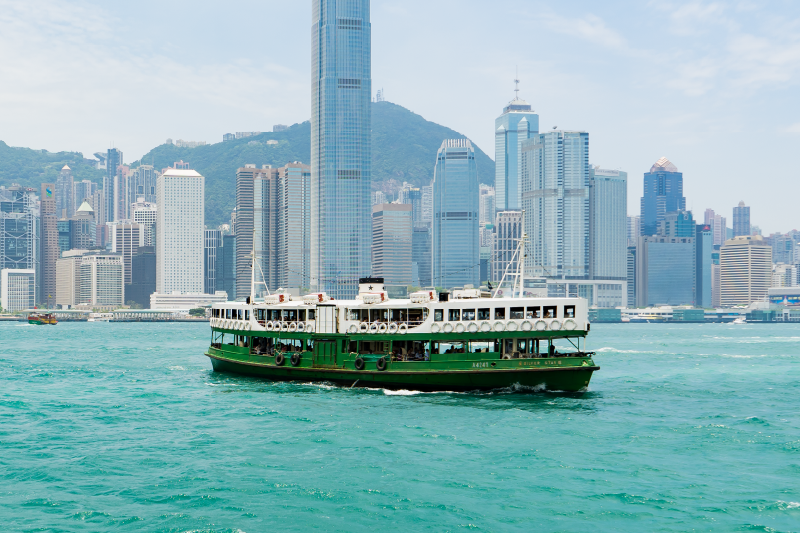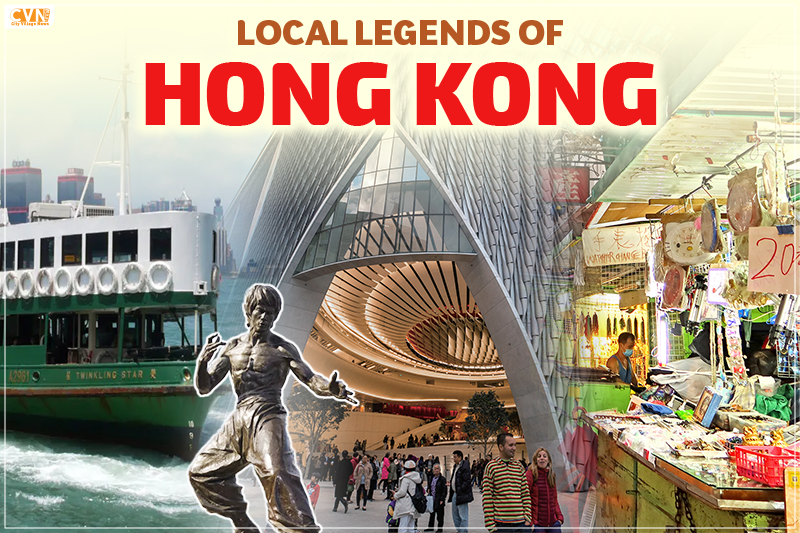Hong Kong doesn’t just impress. It stays with you. Beyond the steel skyline and glossy harbor views lies a city powered by memory, flavor, rhythm, and resilience. Hong Kong’s brand identity isn’t built in boardrooms. It lives in smoky food stalls, crowded street corners, opera stages, and ferry decks.
Here are five local legends of Hong Kong that tell the real story of this city, a place constantly moving but deeply grounded in soul.
Dai Pai Dongs
To sit at a dai pai dong is to experience Hong Kong at its most alive. The noise of woks, the scent of soy sauce in the air, and the heat from the open flame tell a story you can taste. Red stools line the street, filled with people seeking comfort food that has fed generations. In the 1950s, these stalls were everywhere, more than a thousand strong. Now only 17 remain, quietly defying time and modern development.
You’ll find them scattered through Central and Sham Shui Po. Their scents fill narrow lanes. Curry fishballs pop in oil. Milk tea steams in metal cups. Woks crackle with energy. They are history for locals and wonder for visitors. In a city always in motion, these stalls protect what makes it human. They preserve not just flavor, but identity.
Sham Shui Po
Down Pei Ho Street, the echoes of another time still move between market stalls and signboards. A vendor offers vintage CDs beneath a sign faded by time. Not far away, a café brews oat milk lattes in quiet calm. Sham Shui Po holds both memory and momentum. Once overlooked, this working-class district is now a creative force. Co-working studios rise beside tofu pudding shops. Apliu Street, nicknamed Men’s Street, bustles with vintage gadgets and street snacks.
The transformation is careful, not careless. Locals take pride in how the neighborhood has evolved, not by erasing its past but by folding it into the future. This patchwork of tradition and trendiness has become a signature of Hong Kong brand identity. It’s not about nostalgia. It’s about evolution with roots. For many, Sham Shui Po is one of the rising Hong Kong tourism highlights.
Cantonese Opera at Xiqu Centre
Steel curves like fabric at the edge of West Kowloon, but this is not wind. Its intent, captured in the form of the Xiqu Centre. Inside, silence settles over velvet seats before the stage begins to glow. Then come the stories, sung, danced, and whispered, where warriors fight and empresses grieve in tones that reach across time. The city has nurtured Cantonese opera for generations. In 2009, UNESCO recognized it formally, but its value was never in doubt here.
This isn’t nostalgia. Since 2019, the Xiqu Centre has shaped tradition into something new. The lantern-shaped building doesn’t imitate the past; it cradles it, offering short performances in the Tea House Theatre that invite anyone to listen. You don’t need to follow every word. The emotion rises on its own. What unfolds here is more than performance. It’s a ritual, and it still breathes. Cantonese opera remains one of the most enduring cultural icons of Hong Kong.
Avenue of Stars
The Avenue of Stars makes its first impression through stillness. Bruce Lee stands in bronze, mid-movement, facing the open harbor with a presence that needs no introduction. This section of Tsim Sha Tsui recognizes the storytellers who gave Hong Kong its global creative reach. Bruce Lee led that charge. He wasn’t just a martial arts star; he gave the city a new kind of visibility and pride. His statue still invites admiration, with visitors often striking the same pose beside him. The fountain that surrounds him flows with gentle rhythm, guided by feng shui, and carries his signature phrase: “Be formless, shapeless, like water.”

Anita Mui’s likeness stands near the waterfront, her form embodying the presence that defined her Cantopop stardom and her deep connection to Hong Kong. Alongside her, McDull appears with quiet charm, reminding everyone that the city values joy just as much as legacy. This isn’t just a photo-op walkway. It’s a celebration of cultural icons of Hong Kong: from kung fu legends to animated charm. It tells the world that Hong Kong’s story is told through film, music, and laughter, and that legacy still sparkles on the harbor. For visitors, it remains one of the most iconic Hong Kong tourism highlights.
The Star Ferry
You can ride the MTR in two minutes. But take the Star Ferry, and you’ll touch history. For just a few dollars, you board a double-decker ferry painted green and white. The wood creaks. The breeze hums. Crossing Victoria Harbour, the ferry brings the city into view in quiet sequence. Steel buildings rise beyond the mountains, and the atmosphere carries echoes of the past. Since 1888, the Star Ferry has moved through each chapter of Hong Kong’s changing story.

The ferry holds childhood memories for many locals, while tourists often pause in silence to absorb the surroundings. Boats in the fleet are given poetic names like Celestial Star, Shining Star, and Morning Star. To Hong Kong, they are more than ferries; they are symbols. They bridge not just islands but identities. And they tell the world that progress doesn’t always mean leaving things behind. Few moments offer such authentic Hong Kong experiences as this quiet, powerful ride across the harbor.
Conclusion
Some cities are remembered for skylines. Hong Kong is remembered for experiences. It’s the hiss of a wok. The echo of an erhu. The rhythm of ferry waves. The laughter in a market. The pride in a statue’s shadow. These five local legends of Hong Kong aren’t tourist spots. They’re memory-makers. Carriers of identity. They reveal what Hong Kong truly represents. It is a city that holds onto its roots, welcomes change with soul, and turns every moment into a story.
Come for the view.
Stay for the heartbeat.
Ready to experience the charm of Hong Kong? Browse a wide range of flights from USA to Hong Kong offered by leading international carriers. For seamless booking and competitive fares, count on iEagle to make your travel planning easier.
FAQs
What is unique about Hong Kong’s brand identity?
Hong Kong’s brand identity blends fast-paced modern life with deep-rooted traditions. It’s shaped not by boardrooms but by dai pai dongs, opera houses, street markets, and ferries that carry generations of memory.
What are some local legends of Hong Kong worth experiencing?
Key local legends of Hong Kong include dai pai dongs (open-air food stalls), Sham Shui Po’s heritage-rich streets, Cantonese opera at Xiqu Centre, the Avenue of Stars, and the historic Star Ferry.
Where can I find authentic Hong Kong street food?
Authentic Hong Kong street food is best experienced at dai pai dongs, particularly in neighborhoods like Central and Sham Shui Po. These stalls serve classics like curry fishballs, stir-fried noodles, and milk tea.
What makes Sham Shui Po a cultural hotspot in Hong Kong?
Sham Shui Po combines working-class history with emerging creativity. You’ll find vintage shops, tech markets, tofu stalls, and trendy cafés coexisting in a district that honors its past while embracing change.
Why is the Xiqu Centre important to Hong Kong culture?
The Xiqu Centre is a modern home for Cantonese opera, designed to preserve and promote this UNESCO-recognized art form. It offers short, accessible performances in a space that celebrates tradition with modern design.
Who are some cultural icons of Hong Kong featured on the Avenue of Stars?
The Avenue of Stars honors legends like Bruce Lee, Anita Mui, and McDull. It celebrates Hong Kong’s film, music, and animation industries and serves as a tribute to the city’s creative legacy.
What are the top Hong Kong tourism highlights for culture lovers?
For those interested in culture, top Hong Kong tourism highlights include dai pai dongs, Sham Shui Po’s markets, Cantonese opera at Xiqu Centre, the Avenue of Stars, and the historic Star Ferry ride.
| Disclaimer: City Village News claims no credit for the images featured on its blog site. All the visual content is copyrighted to its respective owners only. We mention the source name of the picture whenever possible and found. However, please get in touch with us if we miss acknowledging the owner’s source. In case the owners don’t want us to use their images, we will remove them promptly. We believe in providing proper attribution to the original author, artist, and photographer. |

